1001 Leaders – Interview with Jane Kats
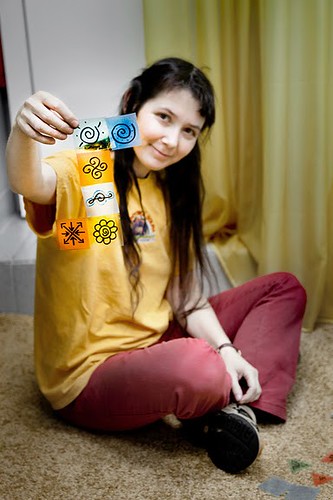
This is an interview with Jane Kats, an early childhood educator, math circle leader, author and math enthusiast.
Jane talks about her math circles, what parents can do to help kids enjoy math, and what they should avoid. Jane shares a couple of activities for you to try with your children.
In our 1001 Circles series, we feature math circles stories from the point of view of a circle leader, who acts as an invisible tour guide. But math circle leaders have to do more than tell stories. They bring together the kids and the math, so that the end result, the circle, is more than the sum of its parts. In 1001 Leaders, the companion series to our 1001 Circles, we put the spotlight on the leaders themselves. What got them started and what keeps them going? What are their math dreams and worries? If you lead a math circle, an engineering club, or an informal playgroup, we would like to hear your story or interview you. Write moby@moebiusnoodles.com to talk about your adventures.
When it comes to early childhood education, Jane seems to do it all, from organizing math circles and family game nights to leading summer camps in Russia, Germany, France, Israel, and the US. In between, she also updates her blog (in Russian). Her energy and love for math are both inspiring and contagious. Her blog and her books, some of which are available in English, are overflowing with games, ideas and insights into how children learn – and not just math.
We asked Jane about her math journey and the advice she can share for helping young kids discover the beautiful adventurous math.
Let’s begin!
Moebius Noodles: Tell us a bit about yourself, please.
Jane Kats: I am 40 years old and have two teenagers; Galina is 14 and Grigoriy is 16. I like to play games, draw, talk to people, travel, and share things that I love, such as games and math. In high school I was in an intensive math program and loved to participate in various math olympiads.
When my children started school, I began leading a math circle for kids in elementary grades. Over time, I began a circle for younger kids (preschoolers and kindergarteners).
I enjoy coming up with ways to explain math problems to children and I am patient if they don’t know or don’t understand something.

MN: What are some of your worries and dreams about your work? How does it feel, doing what you do?
JK: I believe that the biggest mistake adults make is the attitude that “you don’t need to understand, only to memorize the answer”. It doesn’t work! Children who memorize the multiplication tables don’t always understand when to use them.
It is sad that for so many children and adults, math is disconnected from life and is associated only with arithmetic. Topics such as symmetry, graph theory, projections, logics are not being considered. Math teaches one to think, so it should not be reduced to arithmetic!
MN: You do a lot for family math: camps, playgroups, parent consults, materials… How did you start? What keeps you going?
JK: Actually, it’s not just math, but also board games, crafts, and play acting… But math is my love. It saddens me to see that many people associate math with boredom and rote memorization. I’d like to give children the joy of coming up with their own solutions, discoveries and experiments.
MN: Imagine someone who is just starting on a similar path, or maybe yourself when you first started. What would you recommend to that newbie?
JK: You can try things, you can create your own problems, you can change game rules on the fly. The important part is to believe that children love to find out new things; they love to learn! Children can learn not in order to get stickers or stars, but just because it is interesting to them.
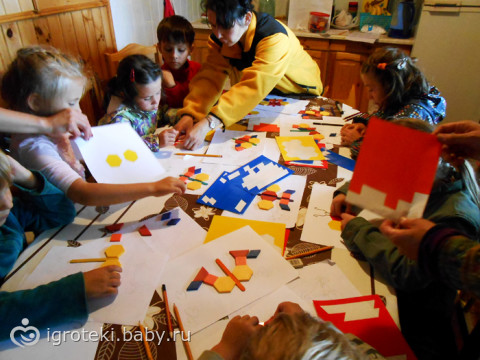
MN: You said that math is your love. Unfortunately, many parents do not share your feeling.
JK: Yes, I know that many adults grew up with the idea that they do not know or love math. And oftentimes they communicate this idea to their children. I try to show parents and teachers that math is very beautiful, show my favorite math games and activities, and show that one can simply play with math. And I repeat over and over that it is not scary or shameful to not know something or to not be able to do something. We all don’t know or can’t do something, but we can learn. We can break a problem into many parts and solve each part.
MN: Many parents want better math experiences for their children, but do not have the opportunity to join an existing math circle. What can they do, particularly if they suffer math anxiety or fear math?
JK: If parents themselves dislike math or are afraid of it, then the least they can do is to avoid generalized statements such as “math is difficult” and “math is boring” and “I don’t understand this, so I can’t help you here”. In my article, “Math for Dessert”, I have not just games, but also specific examples of things kids might not understand and what they might need help with.
Many adults have favorite and not so favorite topics in different disciplines. It is ok. Parents may look for other adults and kids who love math and get to know them better. Or look for math camps.
MN: What can parents who firmly associate math with arithmetic do? Do you know of any math circles that are led not by mathematicians or math teachers or engineers or programmers, but by adults who didn’t understand math back in school, even disliked it?
JK: Well, I am not a mathematician. Even though I graduated from high school in a math program, I have a degree in linguistics. My kids solve many of the complex math problems better than I do. That’s why I like working with little kids – I am ready to understand that math is complex and ready to help them through their challenges.
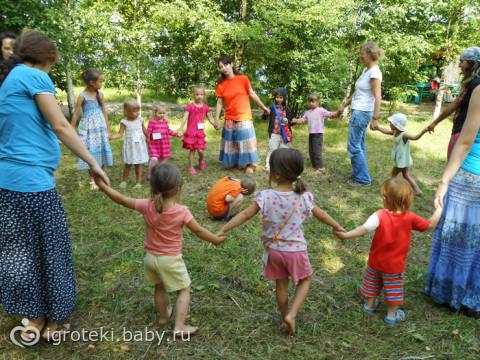
MN: When you work with kids, particularly with very young kids, how do you know that they understand what you are telling them?
JK: I am very cautious about various tests and quizzes. I share Alexander Zvonkin’s [mathematician, math educator and an author] idea that timely questions are much more important than dictated answers and that sometimes it is better to spend a year solving a problem on one’s own than to listen to someone else’s detailed explanation.
Sometimes I give kids difficult problems, above their level, to see how they deal with these. This is not a test, but rather a diagnostic tool for the teacher, something to think about.
In general it is a complex topic, how we check child’s understanding. It requires many specific examples. It mostly depends on the ages of the kids, the level of readiness, and on the talent of the teacher.
If I have a group of preschoolers, then I usually know their skills. I might ask one of the kids to name numbers that are neighbors of the number 3, and then help and show manipulatives. I might ask another child from the same group to name neighbors of the number 19 or ask which number has 37 and 39 as its neighbors. The kids who cannot answer these questions yet, they learn by listening to the answers.
With the first-graders, if we do an activity in which we must split a shape into two congruent shapes, then I start with something very simple so everyone in the group can get the right answer. Later on, when working on more challenging problem, if kids cannot figure it out, I might offer them a simpler version with the elements of the original problem to nudge them in the right direction.
MN: Earlier you mentioned that emphasizing memorizing over understanding is the biggest mistake. Some parents say that memorizing first will make it easier for a child to understand why and how it works.
JK: Yes, this is a mistake made by many teachers, and many parents. I believe it is a very serious mistake. In my view, it is a fundamentally flawed approach. A child does not memorize the meaning, just the words, like a rhyme, and doesn’t understand how to use it.
We have a game called “1, 2, 3, Look!” where I use a box with several compartments. When the kids aren’t looking, I put small groups of 2 to 4 similar objects, like buttons or chestnuts, into the box. Then I show the box to one of the kids for a brief moment and the child must guess how many objects were in the box. When they see 3+1+3 objects, some kids quickly respond with 7, while others cannot answer until I show the box again long enough for them to count the objects. The fact that they memorized the words “three plus four is seven” does not help them.
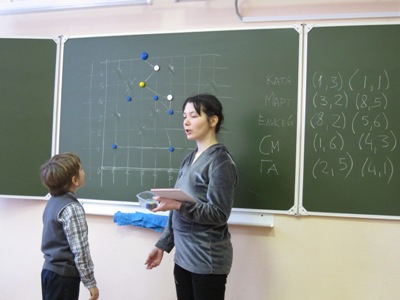
MN: Some parents agree that understanding is better than rote memorization, but are worried that while working on understanding their child will fall behind academic requirements. Others believe that understanding alone is not enough and a child must have a certain level of fluency that can be reached only through rote memorization. Your opinion?
JK: Understanding is more important than rote memorization. Fluency is useful and convenient, and is reached not by rote, but by playing various games. Card games do more for fluency than flash cards.
MN: Many parents do not trust in their own abilities to help their kids learn. They are afraid of making irreversible errors, damaging the kids somehow. Your advice?
JK: I think every parent can find a subject or an area that brings them and their kids joy when explored together. For some it’s math. For others it’s spending time outdoors. For others yet, it’s singing or dance or board games or gardening. I believe it is more important to first find this common interest and then to show kids how you deal with complications that arise.
If parents don’t know much about math, they can frequently be of even greater help to their kids because they will think and talk through the problem slowly, without skipping steps.
MN: What if a child says that he hates math? What then?
JK: I would offer logic games such as Set or Ghost Blitz; math crafts, such as kusudama, symmetry games, or building with toothpicks; puzzles, such as the ones offered by Thinkfun. Then I would tell the child that this too is math. I think many children don’t know how many beautiful and interesting areas there are in math. For me, math circle is a way to show kids the richness of math problems, to teach them to think and reason instead of simply applying a suitable algorithm. It gives kids the chance to experience the joy of finding a solution.
MN: Would you share with our readers a favorite math activity or two?
JK: Stop-Go is one of our favorite games with younger kids. When I say “Stop-1”, the player must stand on 1 leg. “Stop-4” means 2 legs and 2 arms. There are several solutions for “Stop-3”.
We also like playing The Monsters Game. We roll a die and if it shows 5, we draw a monster with 5 heads. Next, we roll the die one more time and draw that many arms. Another roll and we draw that many legs.
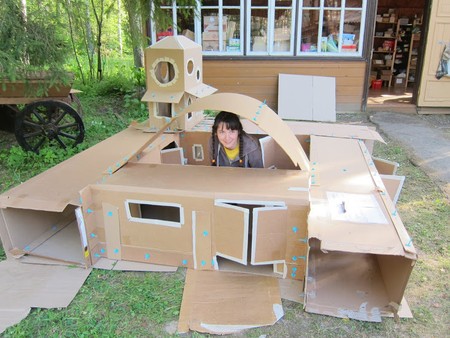
MN: You have a very intense schedule – math circles, game nights, camps all around the world. And you write books! How do you stay energized, enthusiastic, and passionate? How do you deal with the burn-out?
JK: Yes, I have a full schedule, but I get help from volunteers. I enjoy coming up with ideas together, doing things together, and sharing ideas. If I get tired, I go camping or hiking. It helps me recharge.
If you have questions for Jane or would like to learn more about her circles, camps, and books, let us know!
Related Posts
Posted in A Math Circle Journey, Make


















I loved reading this interview! Jane, you lead a life similar to the one I envision for myself in a few years time. I would like to know more about your summer camps – how you plan them, fund them, populate them?